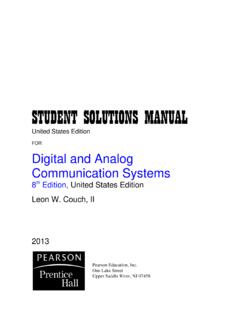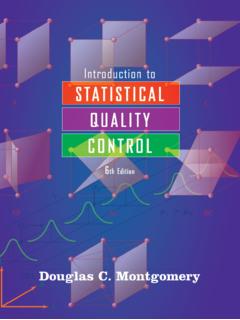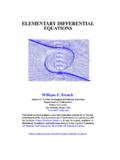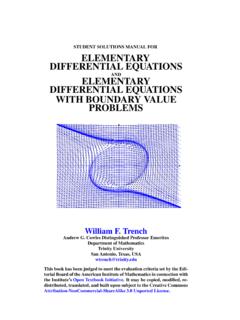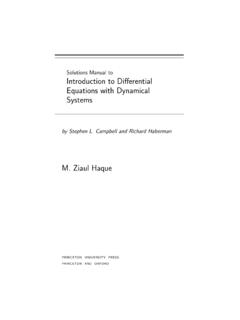Transcription of Student’s Solutions Manual - CRC Press
1 1 Student s Solutions ManualforDifferential Equations:Theory, Technique, and Practicewith Boundary Value ProblemsSecond Editionby Steven G. Krantz (with the assistance of Yao Xie)Chapter 1 What is a DifferentialEquation? Introductory A Taste of Ordinary Differential The Nature of the function is a solution to the differential equation.(a) Ify=x2+c, theny = 2x.(b) Ify=cx2, theny = 2cxsoxy = 2cx2= 2y.(c) Ify2=e2x+c, then 2yy = 2e2xsoyy =e2x.(d) Ify=cekx, theny =kcekxsoy =ky.(e) Ify=c1sin 2x+c2cos 2x, theny = 2c1cos 2x 2c2sin 2xandy = 4c1sin 2x 4c2cos 2x= 4ysoy + 4y= 0.(f) Ify=c1e2x+c2e 2x, theny = 2c1e2x 2c2e 2xandy = 4c1e2x+4c2e 2x= 4ysoy 4y= 0.(g) Ify=c1sinh 2x+c2cosh 2x, theny = 2c1cosh 2x+ 2c2sinh 2xandy = 4c1sinh 2x+ 4c2cosh 2x= 4ysoy 4y= 1. WHAT IS A DIFFERENTIAL EQUATION?(h) Ify= arcsinxy, theny =xy +y 1 (xy)2soxy +y=y 1 x2y2.(i) Ify=xtanx, theny =xsec2x+ tanx=x(tan2x+ 1) + tanx=y/xwe gety =y2/x+x+y/xorxy =x2+y2+y.(j) Ifx2= 2y2lny, then 2x= [2y2(1/y) + 4ylny]y = 2yy (1 + 2 lny).
2 Consequently,y =xy+2ylny. Using lny=x22y2we gety =xyx2+y2.(k) Ify2=x2 cx, then 2yy = 2x cso 2xyy = 2x2 cx=x2+x2 cx=x2+y2.(l) Ify=c2+c/x, theny = c/x2sox4(y )2=c2=y c/x. Usethe fact that c/x=xy to obtainx4(y )2=y+xy .(m) Ify=cey/x, theny =xy yx2cey/x=xyy y2x2. Solve fory to obtainy =y2/(xy y2).(n) Ify+siny=x, theny +y cosy= 1 ory = 1/(1+cosy). Multiplythe numerator and denominator of the right side byyto obtainy =y/(y+ycosy). Now use the identityy=x sinyto obtainy = (x siny+ycosy).(o) Ifx+y= arctany, then 1 +y =y /(1 +y2). Consequently,(1 +y )(1 +y2) =y . This simplifies to 1 +y2+y2y = each of the following differential equations, find the particular so-lution that satisfies the given initial condition.(a) Ify =xex, theny= xexdx+C= (x 1)ex+C(integrate byparts,u=x). Whenx= 1,y=Cso the particular solution isy(x) = (x 1)ex+ 3.(b) Ify = 2 sinxcosx, theny= 2 sinxcosxdx+C= sin2x+ 0,y=Cso the particular solution isy(x) = sin2x+ 1.(c) Ify = lnx, theny= lnxdx+C=xlnx x+C(integrate byparts,u= lnx).
3 Whenx=e,y=Cso the particular solution isy(x) =xlnx x.(d) Ify = 1/(x2 1), theny= 1/(x2 1)dx+C= 1/2 1/(x 1) 1/(x+ 1)dx+C=12lnx 1x+1+C(method of partial fractions).Whenx= 2,y=12ln13+C=C ln 32so the particular solutionisy(x) =12lnx 1x+1+ln THE NATURE OF SOLUTIONS3(e) Ify =1x(x2 4), theny= 1x(x2 4)dx+C= 1/8 1/(x+2)+1/(x 2) 2/xdx+C=18ln|x2 4|x2+C(method of partial fractions).Whenx= 1,y=18ln 3 +Cso the particular solution isy(x) =18ln|x2 4|x2 18ln 3 =18ln|x2 4|3x2.(f) Ify =2x2+x(x+1)(x2+1), theny= 2x2+x(x+1)(x2+1)dx+C=12 1x+1+3x 1x2+1dx+C=12ln(x+1)+34ln(x2+1) 12arctanx+C(method ofpartial fractions). Whenx= 0,y=Cso the particular solutionisy(x) =12ln(x+ 1) +34ln(x2+ 1) 12arctanx+ the differential equationy 5y + 4y= 0,carry out the detailed calculations required to verify these assertions.(a) Ify=ex, theny 5y + 4y=ex 5ex+ 4ex , theny 5y + 4y= 16e4x 20e4x+ 4e4x 0.(b) Ify=c1ex+c2e4x, theny 5y + 4y=c1(ex 5ex+ 4ex) +c2(16e4x 20e4x+ 4e4x which values ofmwill the functiony=ym=emxbe a solution ofthe differential equation2y +y 5y + 2y= 0?)
4 Find three such valuesm. Use the ideas in Exercise 5 to find a solutioncontaining three arbitrary constantsc1, c2, the differential equation to obtain2m3emx+m2emx 5memx+ 2emx= each term (it is never 0) to obtain the equivalent equation2m3+m2 5m+ 2 = thatm=m1= 1 is a solution (andy1=exis a solutionto the differential equation). Using this we can factor the polynomial divide bym 1 to obtain2m3+m2 5m+ 2 = (m 1)(2m2+ 3m 2).4 CHAPTER 1. WHAT IS A DIFFERENTIAL EQUATION?The quadratic term factors yield two more roots,m2= 2,m3= 1/2,and two more solutionsy2=e 2xandy3= three Solutions can be combined, as in Exercise 5, to produce asolution with three arbitrary constantsy=c1ex+c2e 2x+c3 the method of separation of variables to solve each of these ordinarydifferential equations.(a) Write the equationx5y +y5= 0 in Leibnitz formx5dydx+y5= 0and separate the variables:dyy5= dxx5. Integrate, dyy5= dxx5,to obtain the solution:y 4/( 4) =x 4/4 +C. This can also bewritten in the formx4+y4=Cx4y4ory= (x4Cx4 1)1/4.
5 (b) Write the equationy = 4xyin Leibnitz formdydx= 4xyand sepa-rate the variables:dyy= 4xdx. Integrate, dyy= 4xdx, to obtainthe solution: ln|y|= 2x2+C. This can also be written in the formy=Ce2x2.(c) Write the equationy +ytanx= 0 in Leibnitz formdydx+ytanx= 0and separate the variables:dyy= tanxdx. Integrate, dyy== tanxdx, to obtain the solution: ln|y|= ln|cosx|+C. This canalso be written in the formy=Ccosx.(d) The equation (1 +x2)dy+ (1 +y2)dx= 0 can be rearranged andintegrated directly, dy1+y2+ dx1+x2=C. Therefore, the implicitsolution is arctany+ arctanx=C. This can also be written inthe formy= tan(C arctanx).(e) Proceed as in part (d). Rearrangeylnydx xdy= 0 to the formdxx dyylny= 0 and integrate: dxx dyylny=C. This yields theimplicit solution ln|x| ln|lny|=Cwhich can also be written inthe form lny=Cxory=eCx.(f) From Leibnitz formxdydx= (1 4x2) tanywe obtain cotydy=(1/x 4x)dx. Integrating, cotydy= 1/x 4xdx, gives theimplicit solution ln|siny|= ln|x| 2x2+C. Consequently, siny=Cxe 2x2soy= arcsin(Cxe 2x2).
6 FIRST-ORDER LINEAR EQUATIONS5(g) The Leibnitz formdydxsiny=x2separates to sinydy=x2dx. In-tegrate to obtain cosy=x3/3 +Cory= arccos(C x3/3).(h) Write the equationy ytanx= 0 in Leibnitz formdydx ytanx=0 and separate the variables:dyy= tanxdx. Integrate dyy= tanxdx, to obtain the solution: ln|y|= ln|cosx|+C. Thiscan also be written in the formy=C/cosxory=Csecx.(i) From Leibnitz form,xydydx=y 1 we obtainydyy 1=dxx. Writethis in the formy 1+1y 1dy=dxxand integrate to obtain the implicitsolutiony+ ln|y 1|= ln|x|+C.(j) Leibnitz formxy2 dydxx2= 0 separates todxx=y 2dy. Integratingyields the implicit solution ln|x|= 1/y+C. The solution canbe expressed explicitly asy=1C ln|x|. =pyieldsp p=x2. Separation of variables (or directintegration) gives ln|p|=x3/3 +C. This implies thatp=Cex3/3andsoy =Cex3/3. Consequently,y=C ex3/3dx+D. As we expect,the solution contains two arbitrary constants. The integral cannot beevaluated in terms of elementary First-Order Linear the general solution of the following equations.
7 (a) The equation is linear and separable. The integrating factor ise x2/2so it simplifies to (e x2/2y) = 0 ande x2/2y=C. Therefore,y=Cex2/2.(b) This equation is also linear and separable. The integrating factorisex2/2so it simplifies to (ex2/2yy) =xex2/2. Integrate to obtainex2/2y=ex2/2+Candy= 1 +Ce x2/2.(c) The integrating factor isexso the equation simplifies to (exy) =ex1+e2x. Integrating we obtainexy= arctanex+C. The generalsolution isy=e xarctan(ex) +Ce x.(d) The integrating factor isexso the equation simplifies to (exy) =2x+x2ex. Integrate to getexy=x2+(2 2x+x2)ex+C(integrate6 CHAPTER 1. WHAT IS A DIFFERENTIAL EQUATION?x2exby parts, twice, or use an integral table). The general solutionisy=x2e x+ 2 2x+x2+Ce x.(e) Write asxy = 2y x3and theny (2/x)y= x2. The integratingfactor isx 2so the equation simplifies to (x 2y) = 1. Integrateto obtainx 2y= x+C. The general solution isy= x3+Cx2.(f) The integrating factor isex2so the equation simplifies to (ex2y) =0. Consequently,ex2y=Candy=Ce x2.
8 (g) Write asy (3/x)y=x3. The integrating factor isx 3so theequation simplifies to (x 3y) = 1. Integrating we obtainx 3y=x+Csoy=x4+Cx3.(h) Express the equation in the formy +2x1+x2y=cotx1+x2. The integrat-ing factor is 1 +x2and the equation simplifies to ((1 +x2)y) =cotx. Consequently, (1 +x2)y= ln|sinx|+Candy=ln|sinx|+C1+x2.(i) The integrating factor is sinxand the equation simplifies to (ysinx) =2x. Therefore,ysinx=x2+Candy=x2+Csinx.(j) Express the equation in the formy + (1/x+ cotx)y= 1. The in-tegrating factor isxsinxso the equation simplifies to (xysinx) =xsinx. Integrate to obtainxysinx= sinx xcosx+C(use atable of integrals or integratexsinxby parts,u=x). Therefore,y=sinx xcosx+ Bernoulli EquationsTo verify the technique write the Bernoulliequation in the formy ny +P y1 n=Q. The substitutionz=y1 nandz = (1 n)y ny yield11 nz +P z=Q.(a) Bernoulli,n= 3. Substitutez=y 2,z = 2y 3y intoxy 3y +y 2=x4to obtain ( 1/2)xz +z=x4. This is linear,z (2/x)z= 2x3, with integrating factorx 2.
9 It simplifies to (x 2z) = ,x 2z= x2+Candz= x4+Cx2. This meansthaty 2=Cx2 x4soy2=1Cx2 x4.(b) Write the equation in the formy + (1/x)y=y 2cosxto seethat it is Bernoulli,n= 2. Substitutez=y3,z = 3y2y intothe equationy2y + (1/x)y3= cosxto obtain the linear equation(1/3)z + (1/x)z= cosx. This isz + (3/x)z= 3 cosx, with inte-grating factorx3. It simplifies to (x3z) = 3x3cosx. Consequently,x3z= 3F(x) +CwhereF(x) is and antiderivative FIRST-ORDER LINEAR EQUATIONS7 Therefore,z= 3x 3F(x)+x 3C, and the solution in terms ofycanbe expressed in the formy3x3= 3F(x) +C. The expressionF(x)can be found using multiple integration by parts or, better yet, atable of integrals:F(x) =x3sinx+ 3x2cosx 6xsinx 6 (x) +g(x), theng =cf (x) +g (x). Estimate the constantc(multiply the first equation byf (x), the second byf(x), and subtract)to obtainf (x)y f(x)y =f(x)g(x) f (x)g (x). This is a first-orderlinear equation is linear. Write it in the formy (2 csc 2x)y=2 cosxsin 2xto find the integrating factor: csc2x+ cot 2x= cotx.
10 Since2 cosxsin 2x=2 cosx2 sinxcosx= cscx, upon multiplying by the integrating factor we ob-tain (ycotx) = cscxcotx. Therefore,ycotx= cscx+Candy= cscx+Ccotx. Converting to sines and cosines yieldsy=Csinx 2the denominator approaches 0. To get a finite limit thenumerator must also approach 0 so letC= 1. The solutiony=sinx 1cosxhas the desired (t) be the amount of salt (pounds) in the tank at timet(minutes).The rate of change,x (t), equals the rate in: 6 lbs/min, minus the rateout: 3 x(t)V(t)lbs/min, whereV(t) = 40 tis the volume of the mixture inthe tank at timet. The resulting rate equation:x = 6 3 x40 t, is it asx +340 tx= 6 to obtain the integrating factor, (40 t) equation simplifies to [(40 t) 3x] = 6(40 t) 3implying that(40 t) 3x= 3(40 t) 2+C. Consequently,x(t) = 3(40 t)+C(40 t) initial condition,x(0) = 0, determines the value of the constant:C= 31600. Therefore, the amount of salt in the tank at timetis givenbyx(t) = 3(40 t) 31600(40 t)3.(a) SinceV(t) = 40 tthere are 20 gallons of brine in the tankwhent= 20.


